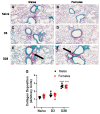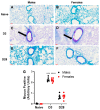Factors Contributing to Sex Differences in Mice Inhaling Aspergillus fumigatus
- PMID: 33260764
- PMCID: PMC7729525
- DOI: 10.3390/ijerph17238851
Factors Contributing to Sex Differences in Mice Inhaling Aspergillus fumigatus
Abstract
Aspergillus fumigatus is a respiratory fungal pathogen and an allergen, commonly detected in flooded indoor environments and agricultural settings. Previous studies in Balb/c mice showed that repeated inhalation of live and dry A. fumigatus spores, without any adjuvant, elevated allergic immune response and airway remodeling. Sex-specific differences can influence host-pathogen interactions and allergic-asthma related outcomes. However, the effect of host sex on immune response, in the context of A. fumigatus exposure, remains unknown. In this study, we quantified the multivariate and univariate immune response of C57BL/6J mice to live, dry airborne A. fumigatus spores. Our results corroborate previous results in Balb/c mice that repeated inhalation of live A. fumigatus spores is sufficient to induce mucus production and inflammation by day 3 post last challenge, and antibody titers and collagen production by day 28 post-challenge. Principal Component Analysis (PCA) showed that females exhibited significantly higher levels of immune components than males did. Taken together, our data indicate that host-sex is an important factor in shaping the immune response against A. fumigatus, and must be considered when modeling disease in animals, in designing diagnostics and therapeutics for A. fumigatus-associated diseases or while drafting evidence-based guidelines for safe mold levels.
Keywords: IgE; airway remodeling; collagen; mucus; principal component analysis.
Conflict of interest statement
The authors declare no conflict of interest.
Figures






Similar articles
-
The impact of Aspergillus fumigatus viability and sensitization to its allergens on the murine allergic asthma phenotype.Biomed Res Int. 2013;2013:619614. doi: 10.1155/2013/619614. Epub 2013 Aug 26. Biomed Res Int. 2013. PMID: 24063011 Free PMC article.
-
An inhalation model of airway allergic response to inhalation of environmental Aspergillus fumigatus conidia in sensitized BALB/c mice.Med Mycol. 2010 Dec;48(8):1056-65. doi: 10.3109/13693786.2010.485582. Epub 2010 May 20. Med Mycol. 2010. PMID: 20482452 Free PMC article.
-
Subchronic exposures to fungal bioaerosols promotes allergic pulmonary inflammation in naïve mice.Clin Exp Allergy. 2016 Jun;46(6):861-70. doi: 10.1111/cea.12724. Epub 2016 May 3. Clin Exp Allergy. 2016. PMID: 26892490 Free PMC article.
-
Allergic Inflammation in Aspergillus fumigatus-Induced Fungal Asthma.Curr Allergy Asthma Rep. 2015 Oct;15(10):59. doi: 10.1007/s11882-015-0561-x. Curr Allergy Asthma Rep. 2015. PMID: 26288940 Review.
-
Aspergillus fumigatus in cystic fibrosis: An update on immune interactions and molecular diagnostics in allergic bronchopulmonary aspergillosis.Allergy. 2017 Nov;72(11):1632-1642. doi: 10.1111/all.13204. Epub 2017 Jun 9. Allergy. 2017. PMID: 28513848 Review.
Cited by
-
A New Overview of Sex Bias in Fungal Infections.J Fungi (Basel). 2024 Aug 26;10(9):607. doi: 10.3390/jof10090607. J Fungi (Basel). 2024. PMID: 39330367 Free PMC article. Review.
-
Epidermal Club Cells in Fishes: A Case for Ecoimmunological Analysis.Int J Mol Sci. 2021 Feb 1;22(3):1440. doi: 10.3390/ijms22031440. Int J Mol Sci. 2021. PMID: 33535506 Free PMC article. Review.
-
Sex-specific alterations in the gut and lung microbiome of allergen-induced mice.Front Allergy. 2024 Aug 15;5:1451846. doi: 10.3389/falgy.2024.1451846. eCollection 2024. Front Allergy. 2024. PMID: 39210977 Free PMC article.
-
The conneXion between sex and immune responses.Nat Rev Immunol. 2024 Jul;24(7):487-502. doi: 10.1038/s41577-024-00996-9. Epub 2024 Feb 21. Nat Rev Immunol. 2024. PMID: 38383754 Free PMC article. Review.
-
Distribution and Epidemiological Characteristics of Clinical Isolates of A. fumigatus in a Hospital from 2021 to 2023: A Retrospective Study.Infect Drug Resist. 2025 Feb 28;18:1199-1208. doi: 10.2147/IDR.S507944. eCollection 2025. Infect Drug Resist. 2025. PMID: 40040851 Free PMC article.
References
-
- U.S.G.A. Office . GAO-08-980. Government Accountability Office; Washington, DC, USA: 2008. [(accessed on 27 November 2020)]. Indoor Mold: Better Coordination of Research on Health Effects and More Consistent Guidance Would Improve Federal Efforts; pp. 1–65. Available online: https://www.gao.gov/assets/290/282305.pdf.
Publication types
MeSH terms
Grants and funding
LinkOut - more resources
Full Text Sources
Medical

